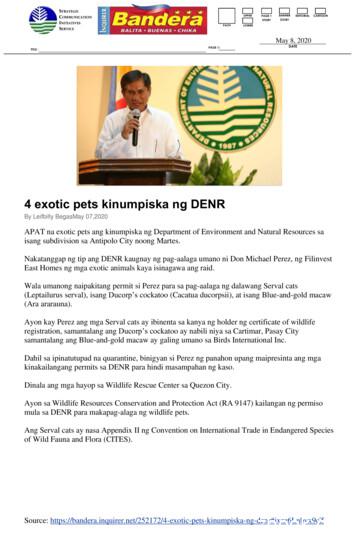IMPORTANT WILD EXOTIC PLANTS DIVERSITY FROM
www.epitomejournals.com Impact Factor 3.656, Vol. III, Issue VI, June 2017, ISSN: 2395-6968IMPORTANT WILD EXOTIC PLANTS DIVERSITY FROM PRAVARABASIN, MAHARASHTRA* Sonawane B N** Sumia Fatima* Shri Dnyaneshwar Mahavidyalaya, Newasa, Dist. Ahmednagar (M. S.)** Dr Rafiq Zakaria College for Women, Navkhanda, Jubilee Park, AurangabadMail : sbn3310@gmail.comABSTRACTAn exotic plant is a species that have native in one place, but has been moved to a newgeographic location due to human interference. Present investigation is aimed at gatheringinformation of useful exotic species occurring in Pravara basin which have been ignored so far.Investigations of the remote areas where Pravara basin dwellers are reside for data collection,identification and documentation of the plants. Collection and conservation of exotic plants usedby local people with special reference to wild relatives of cultivated plants. This will ultimatelygive the information of the use of plants which have not been given much attention by earlierworkers. Present investigation total 62 exotic plants were observed from Pravara basin,Ahmednagar districts. Out of these 62 exotic plants 5-climer, 16- herb, 11- shrub and 29 treesare recorded. Total 27 exotic plants families were observed, among Euphorbiaceae,Caeslpinaceae and Fabaceae families are dominant.KEYWORDS : Exotic plant species, Pravara basin, Maharashtra, India92 SBN & SFDr. Pramod Ambadasrao Pawar, Editor-in-Chief EIJMR, All rights reserved.
www.epitomejournals.com Impact Factor 3.656, Vol. III, Issue VI, June 2017, ISSN: 2395-6968RESEARCH PAPERIntroductionPravara is the important smallest river or stream of the major Godavari river located in westernpart of Ahmednagar districts, Maharashtra, India. The river originates in Western Ghats andmeets to Godavari River. The water sources of Pravara River are Sahayadris hills of WesternGhats. Pravara River is occupying more or less the central position in the Maharashtra state andwith an area of 6537 km2 (2524 sq mi). It is situated between 19 31'45”N and 73 45'5” Elatitude and is situated somewhat in the upper Godavari basin. The Pravara River is havinglength of 208 kms. Occurrence of exotic plants in Indian subcontinent can be trace from thetimes of ‘Veda’, ‘Ramayana’, and ‘Mahabharata’ and even in the Ayurvedic literature severalexotic plants have been mentioned as useful. In recent few decades due to increasing trade andtrans-continental transport, the vegetation of Indian subcontinent have been subjected to changesthereby resulting in the introduction of exotic species from different parts of the world. Presentresearch is aimed at gathering information of useful exotic species occurring in Pravara basinwhich have been ignored so far. Following are the works done on the exotic plants of Indiaregion wise. Madhya Pradesh, India (Maheshwari, 1960), Gangtok (Hajra & Das, 1982),Allahabad district (Shama, 1984), Kashmir Himalaya (Singh & Mishri, 1974; Singh & Kachroo,1983), Exotics of Kodaikanal and Palni Hills (Matthew, 1969), Exotics of Rajasthan (Pandey &Parmar, 1994), Ranchi, Bihar (Mahashwari & Paul, 1975) and South Gujarat (Kshirsagar, 2005).Most of these works emphasized on the listing or making floristic accounts of exotic plantspecies.Material and MethodsThe present research involved extensive ethnobotanical studies, survey and collection of exoticplants in different localities from Pravara basin, Ahmednagar district. During the fieldworkvoucher specimens of each plant were collected and numbered by following standard methods(Jain and Rao, 1976). Plants specimens were identified with the help of keys to the families,genera and species provided in reputed floras like Cooke (1958), Singh et al (2000 & 2001),Pradhan and Singh (1999), etc. Balapure, et. al. (1987), Hopkins, (1901), Karnick, (1975),Macdonell & Keith, (1912), Sagreiya, (2005), Shastri, (1957), Tulsidas, Goswami, (1966) andVarma, Dipti (2015), and information about use in Ayurveda are based on Kapoor (2001).93 SBN & SFDr. Pramod Ambadasrao Pawar, Editor-in-Chief EIJMR, All rights reserved.
www.epitomejournals.com Impact Factor 3.656, Vol. III, Issue VI, June 2017, ISSN: 2395-6968Result and discussionThe research investigation deals with 62 different exotic plant species which are observed fromPravara basin in Ahmednagar district of Maharashtra.Table No.1 List of important Exotic plants from Pravara basinSr. No. Plant Botanical NameLocal NameFamily1Ipomoea carneaBeshramConvolvulaceae2Mucuna pruriensKhaj kuhiriFabaceae3Caesalpinia bonducSagargoataCaesalpiniaceae4Cassia occidentalisRantakalaCaesalpiniaceae5Ziziphus mauritianaBorRhamnaceae6Bauhinia racemosaApataCaesalpiniaceae7Acacia niloticaBabhulMimosaceae8Achyranthes asperaAghadaAmaranthaceae9Albizia lebbeckSirasMimosaceae10Carissa congestaKarvandApocynaceae11Datura stramoniumDhotraSolanaceae12Eucalyptus citriodoraNilgiriMyrtaceae13Lawsonia inermisMehandiLythraceae14Bidens biternataChikataAsteraceae15Cassia fistulaBahavaCaesalpiniaceae16Euphorbia geniculataDudhaniEuphorbiaceae17Euphorbia hirtaDudhiEuphorbiaceae18Phyllanthus amarusBhuiawalaEuphorbiaceae19Butea monospermaPalasFabaceae20Ricinus communisErendEuphorbiaceae21Tamarindus indicaChinchCaesalpiniaceae22Aloe veraKorphadLiliaceae23Opuntia strictaNagphaniCactaceae24Annona squamosaSitaphal.Annonaceae25Boerhavia repensPunernawaNyctaginaceae94 SBN & SFDr. Pramod Ambadasrao Pawar, Editor-in-Chief EIJMR, All rights reserved.
www.epitomejournals.com Impact Factor 3.656, Vol. III, Issue VI, June 2017, ISSN: 2395-696826Acacia nilotica27Parthenium hysterophorus Congress-gavat. Asteraceae28Triumfetta rhomboideaKutri-MajriMalvaceae29Alternanthera sessilisChimutkataAmaranthaceae30Ficus racemosaUmberMoraceae31Syzygium cuminiJambulMyrtaceae32Calotropis proceraRui.Asclepiadaceae33Cassia obtusifoliaTakalaCaesalpiniaceae34Celosia argenteaKombadaAmaranthaceae35Delonix regiaGulmoharCaesalpiniaceae36Sapindus emarginatusReethaSapindaceae37Jatropha curcasJangli-erandEuphorbiaceae38Leucaena latisiliquaSubabhulFabaceae39Euphrobia tirucalliSherEuphorbiaceae40Santalum albumChandanSantalaceae41Borassus flabelliferTadArecaceae42Lantana camaraGhaneriVerbanaceae43Malachra capitataRanbhendiMalvaceae44Moringa oleiferaShevgaMoringaceae45Samanea samanRaintreeMimosaceae46Coccinia grandisTondli.Cucurbitaceae47Datura innoxiaDhotra.Solanaceae48Jatropha gossipifoliaMogali ErandEuphorbiaceae49Ipomoea cairicaGarwelConvolvulaceae50Thespesia populneaBhendi zadMalvaceae51Sesbania grandifloraHatgaFabaceae52Prosopis julifloraVedibabulFabaceae53Clitoria ternateaGokarnaFabaceae54Terminalia catappaBadam.Combretaceae55Datura metalKala DhotaraSolanaceae95 SBN & SFBabhulMimosaceaeDr. Pramod Ambadasrao Pawar, Editor-in-Chief EIJMR, All rights reserved.
www.epitomejournals.com Impact Factor 3.656, Vol. III, Issue VI, June 2017, ISSN: 2395-696856Emblica officinalisAvalaEuphorbiaceae57Ocimum americanumRan–tulsiLamiaceae58Mirabilis jalapaGulbakshNyctaginaceae59Adansonia digitataGorakhchinchMalvaceae60Blumea erianthaNirmudiAsteraceae61Melia azedarachBakamMeliaceae62Terminalia arjunaArjun sadadaCombretaceaePresent investigation total 62 exotic plants were observed from Pravara basin, Ahmednagardistricts. Out of these 62 exotic plants 5-climer, 16- herb, 11- shrub and 29 tree are recorded.Total 27 exotic plants families were observed, among Euphorbiaceae, Caeslpinaceae andFabaceae families are dominant and Lamiaceae, Cucurbitaceae, Arecaceae, Sapindaceae,Moraceae, Cactaceae, Liliaceae, Lythraceae and Rhamnaceae are recessive.96 SBN & SFDr. Pramod Ambadasrao Pawar, Editor-in-Chief EIJMR, All rights reserved.
www.epitomejournals.com Impact Factor 3.656, Vol. III, Issue VI, June 2017, ISSN: 2395-6968REFERENCESBalapure, K. M., J. K. Maheshwari & R. K. Tandon. (1987). Plants Of Ramayana AncientScience of Life, Vol No. Vii No. 2, 76 – 84.Cooke T. (1967). The flora of the presidency of Bombay, Vol I-III., (Reprinted Under theauthority of the Government of India) Botanical Survay of India.Hajra P.K. and Das B.K. (1982). Vegetation of Gangtok with special reference to exotic plants.Indian Forester 107: 554‐566.Hopkins, E. W. (1901). Epic versification” The Great Epic of India. New York: C. Scribner’sSons. Pp191-192.Jain S.K. & Rao R.R., (1976). A Handbook of Field & Herbarium Methods, New Delhi.Kapoor, L. D. (2001). Ayurvedic Medicinal Plants. CRC Press, Boca Raton, London.Karnick, C. R. Ethnobotanical records of drug plants described in Valmiki Ramayana and theiruses in Ayurvedic system of medicine Quart. J. Crude drug Res. 13, pp. 143 – 154 (1975).Kshirsagar S.R. (2005). Origin, present status and distribution of exotic plants in south Gujarat.Indian Journal of Forestry 28: 136‐143.Macdonell and Keith 1912. Asvalayana Srauta Sutra, Sankhayana Srauta Sutra; II: 55.Mahashwari J.K. (1960a). The origin and distribution of the naturalized plants of KandwaPlateau‐Madhya Pardesh. Journal of Biological Science 3: 9‐19.Maheshwari, J.K. & S. R. Paul. (1979).The Exotic Flora of Ranchi. J. Indian Bot. Soc. 72(1):149– 167.Matthew K.M. (1969). Exotic flora of Kodaikanal and Palni hills. Records of Botanical Survey ofIndia 20(1): 1‐241.Pandey R.P. and Parmar P.J. (1994). The exotic flora of Rajasthan. Journal of Economic andTaxonomic Botany 18(1): 105‐121.Pradhan, S. G. & N. P. Singh. (1999). Flora of Ahmednagar District (Maharashtra).Sagreiya, K P 2005. Forest and Forestry, National Book Trust, India.Sharma B.D. (1984). Exotic flora of Allahabad. BSI, Dehra Dun.Shastri, H. P. The Ramayana of Valmiki (translated) Shanti Sadan, London. (1957).Singh G. and Kachroo P. (1983). Exotic trees and shrubs of Kashmir. Indian Forester 109:60‐76.97 SBN & SFDr. Pramod Ambadasrao Pawar, Editor-in-Chief EIJMR, All rights reserved.
www.epitomejournals.com Impact Factor 3.656, Vol. III, Issue VI, June 2017, ISSN: 2395-6968Singh, G. and Misri, B. (1974). Some exotic ornamentals of Kashmir. Indian Journal ofHorticulture. 31: 834.Singh, N.P., P. Lakshminarsimhan, S. Kartikeyan and P.V. Prasanna. (2001). Flora ofMaharashtra state. Dicotyledons vol.1 & 2. BSI, Kolkata.Tulsidas, Goswami, 1966. Ramcharit Manas. Gita Press; Gorakhpur.Varma, Dipti,(2015). Medicinal Plants Used During The Period Of Ramayana, InternationalJournal For Exchange Of Knowledge; 2 (1): 41-44.98 SBN & SFDr. Pramod Ambadasrao Pawar, Editor-in-Chief EIJMR, All rights reserved.
Matthew K.M. (1969). Exotic flora of Kodaikanal and Palni hills. Records of Botanical Survey of India 20(1): 1‐241. Pandey R.P. and Parmar P.J. (1994). The exotic flora of Rajasthan. Journal of Economic and Taxonomic Botany 18(1): 105‐121. Pradhan, S. G. & N. P. Singh. (1999). Flora
Invasive Exotic Plant - An aggressive plant that is known to displace native plant species. Invasive exotic species are unwanted plants which are harmful or destructive to man or other organisms (Holmes, 1979; Webster). State Listed Noxious Weeds – Invasive exotic plants prohibited or restricted by Colorado Law.
tion diversity. Alpha diversity Dα measures the average per-particle diversity in the population, beta diversity Dβ mea-sures the inter-particle diversity, and gamma diversity Dγ measures the bulk population diversity. The bulk population diversity (Dγ) is the product of diversity on the per-particle
diversity of the other strata. Beta (β) Diversity: β diversity is the inter community diversity expressing the rate of species turnover per unit change in habitat. Gamma (γ) Diversity : Gamma diversity is the overall diversity at landscape level includes both α and β diversities. The relationship is as follows: γ
AFMC Diversity, Equity, Inclusion and Accessibility (DEIA) Training 2 2 Diversity in BusinessDiversity in Business 3 Minutes 3 The Importance of Diversity The Importance of Diversity3 Minutes 4 The Power of Diversity 4 Minutes The Power of Diversity 5 The Threat of Diversity 2 Minutes The Threat of Diversity 6 Diverse Teams Deliver Results 1 Minute Diverse Teams Deliver Results
Exotic Melee Weapons Improvised Weapons Unarmed Melee Weapons Throwing Weapons Ballistic Projectiles Exotic Ranged Weapons Hold-Out Pistols Tasers Light Pistols Heavy Pistols SMGs . Mace 4 1 (STR 5)P -3 4 150 SR4:Ars Victorinox Smart Staff –
4 exotic pets kinumpiska ng DENR By Leifbilly BegasMay 07,2020 APAT na exotic pets ang kinumpiska ng Department of Environment and Natural Resources sa isang subdivision sa Antipolo City noong Martes. Nakatanggap ng tip ang DENR kaugnay ng pag-aalaga umano ni Don Michael Perez, ng Filinvest East Homes ng mga exotic animals kaya isinagawa ang raid.
- Medicinal plants are contraindicated with other medications; seek medical advice. Proper research and understanding of edible wild plants are important in order to recognize and/or communicate the cautions associated with some wild plants to customers. Product cautions should be clearly and prominently labelled on items before sale.
RP-2 ISO 14001:2015 Issued: 8/15/15 DQS Inc. Revised: 5/12/17 Introduction This Environmental Management System Assessment Checklist is a tool for understanding requirements of ISO14001:2015 “Environmental management systems – Requirements with guidance for use”. The Checklist covers Clauses 4-10 requirements with probing questions about how an organization has addressed requirements and .























